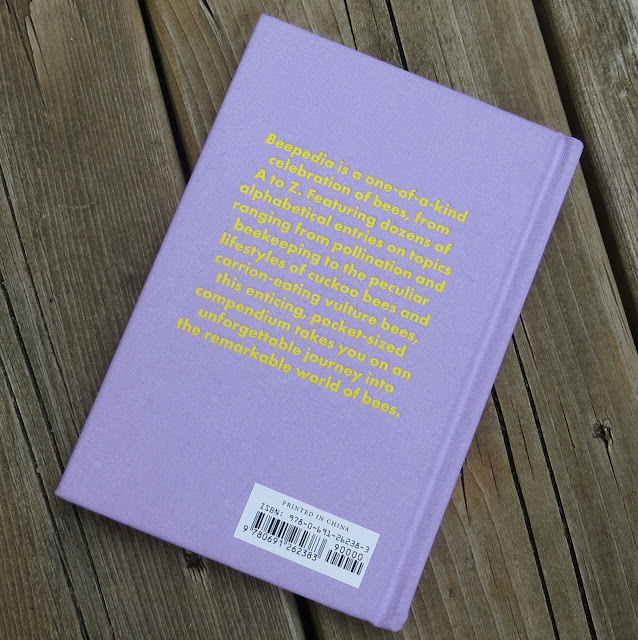Much has been written in the popular press of late about the decline of bees and the implications for humans and our food supply. Yes, much has been written, but little has been done, so the publication of Beepedia is timely in so many ways.
Laurence Packer is a distinguished Canadian bee expert and needs no introduction as a melittologist of note. As always, let me also give a nod to the illustrator, (Ann Sanderson in this instance), whose excellent drawings enhance the text in a very pleasing way.
The standard format for this series is followed, with entries from A to Z. Everything from pure science to the role of bees in popular culture, folklore and religious observance is included. Many of the "pedia" books are infused with a good deal of wry humour, sometimes comical enough to elicit a laugh and more than a few wry smiles. Packer does not overwhelm us with whimsy and satire, but the solid science is more than adequate compensation.
For the novice a complete understanding of bees, both wild and domesticated, can be gained from this little book. You will understand what makes a bee a bee, what threats they are facing, ways in which you might help, and you will become familiar with the practice of "beewashing." More hives are not always - in fact hardly ever - the solution to bees' problems. That warm and fuzzy feeling you get when your city touts its environmental ethic by announcing more rooftop hives is usually misplaced. Western Honey Bees (Apis mellifera), in hives containing thousands of individuals, can quickly outstrip food availability, excluding native species in the process.
Many interesting facts may be gleaned from this book. Who knew that Napoleon Bonaparte chose the bee as his emblem? Or that one Brazilian woman described over 330 bee species. Lucky the person who walked by her office door at the time she was trying to come up with a name for a new species. She named taxa in this manner and ordinary citizens were immortalized in science forever!
It's a great little book with a mountain of information from an impeccable scientist. Read, enjoy, learn - and help the bees in your area. If we all do it we can make a difference.
Laurence Packer
Illustrated by Ann Sanderson
Hardcover - US$17.95 - ISBN: 9780691262383
176 pages - 4.5 x 6.75 inches (11.25 x 16.875 cm)
51 black-and-white illustrations
Publication date: 17 June, 2025





























I really enjoyed your review, David. Of course the book deserves it, the pictures and design are beautiful. I'm a little afraid of bees, but they are better than wasps, which are aggressive. Bees bring a lot of benefits, I love honey!
ReplyDeleteSome wasps are more aggressive to be sure, Nadezda, but they too have an important role to play in a healthy ecosystem, and left alone and treated with respect, they bother humans very little.
DeleteI do hope it is not too late... but worry.
ReplyDeleteThere is more than enough reason to worry, Sue.
DeleteThank you so much for introducing yet another book in the excellent 'pedia series.
ReplyDeleteThe bees are such a concern! Thanks for this insightful review of a much needed excellent book!
ReplyDelete...it bee interesting!
ReplyDeleteThis looks like a great little book. I'm heading off to Amazon to check it out. This series looks interesting, including dogopedia. Thanks for sharing. hugs-Erika
ReplyDeleteOur ecosystems would suffer if bees disappear. They are little heroes of the nature.
ReplyDeleteThis looks like an excellent book. I like this pedia series!
ReplyDeleteI wonder how many "pedia" books there are? You've featured many David, and they all deal with interesting topics. I have seen very few bees this summer. I'm so worried about them!
ReplyDeleteHugs and kisses, Marit
Hi, Marit: Fourteen titles have been published in this series. I have reviewed ten of them. Hugs and kisses - David
DeleteWow! That's a good initiative to bring out a "beepedia". Very timely since bees are getting rarer.
ReplyDeleteA beautiful history of bees related to people who did something for civilization.
ReplyDeleteBeautiful book of the bee. Have a nice day. !
ReplyDeleteThank you for the great review. This book is now on my list.
ReplyDeleteI am back to let you know I purchased this book David. Thank you so much for sharing it. I am enjoying it very much!
DeleteI learn more about bees and other critters on your blog that I even will from books... keep these coming. I might even retain more of it because you said it and I know I can ask you again if I want to know...
ReplyDeleteAsk me as many times as you want, Sandra.
DeleteI need this book! Bees are among my favorite critters and their decline is a source of distress for me.
ReplyDeleteI love the cover on this book, David, and what a great review. Thank you so much for sharing.
ReplyDeleteWow, this looks really good! From how you described it, it seems like it really can be a very useful publication.
ReplyDeleteAnd I didn't know that Napoleon chose a bee as his symbol... you really do learn something new every day.
You’ve done a lovely job balancing appreciation for the author’s scientific rigor with an acknowledgment of the book’s accessibility and engaging style.
ReplyDeleteThis does look an excellent book.
ReplyDeleteMany thanks for your review.
All the best Jan
I've always given bees and wasps a wide berth, though not necessarily for ecological reasons.
ReplyDeleteBees will rarely bother you, Kirk. Wasps are more aggressive, especially at certain times of the year.
DeleteInteresting about too many hives being a negative. Thanks for sharing, David:) Have a grand one.
DeleteI know you showed and reviewed this book just for me. LOL Thanks and I will look for this one.
ReplyDeleteThis seems like a great book David.
ReplyDeleteThere is reason to worry that the bees are declining so much.
I wish you a nice Wednesday.
Greetings Irma
It looks like a very interesting book indeed. :-D
ReplyDeleteThanks for sharing your discovery David !
ReplyDeleteBees are essential !!!! Men with pesticides and Asian hornet are killing them !
Take care !
Bisous
Anna
A good review. We need bees.
ReplyDeleteDavid!
ReplyDeleteI am delighted with your review. Beautiful book. The bee is an extraordinary insect that is irreplaceable and priceless in our ecosystem.
Greetings:)
Have an exceptional one. Stay cool. Stay hydrated.
ReplyDeleteThis kind of book would be wonderful for young people. Not many parents seem to transmit the knowledge of the importance of the bees, also to us humans.
ReplyDeleteI wonder if I'm the only one irritated by Rowan Atkinson's Man vs. Bee series. A wasp instead of a bumblebee would have been slightly more apt. :)
Best wishes from Finland. The unsettled weather continues here and it's lovely.
I have not seen this Rowan Atkinson series, Sara. I will have to look for it.
DeleteI was not familiar with the term "melittologist"........ Google must not know what it is either because he's not answering me so I'm still in the dark..Aha..."the scientific study of bees""..I always learn something from you...😍
ReplyDeleteIt sounds quite interesting. Unfortunately, people have such a hatred for insects that they poison them indiscriminately, killing off bees.
ReplyDeleteThis is a book I think I should have. Two days ago I spotted a black and white bee here in the lavender, I struggled to get ID, eventually I think it is Thyreus ramosus, but it could be Thyreus orbatus, I gather the can only be told apart under a microscope! You might get to see it on one of my blogs one day :-)
ReplyDeleteI hope all is well. Ridiculously hot here 38C due on Tuesday and we have to go out! Bisous mon ami, Diane
Just back from three days away at my oldest grandson’s wedding, Diane, so I too may be playing catch-up for a few days. Bisous - David
DeleteWhat a lovely little book. In fact, all those "pedia" books look delightful and I'm sure they are full of useful facts and illustrations, like to ones in your bee book.
ReplyDeleteFascinating book, David. My knowledge of bees is limited but this pedia collection you mention is on my list. Thank you!
ReplyDeleteXO
WWW
I LOOOVE bees! I've actually read a few books about bees to help me develop an alien race in my science-fiction series I'm writing. My favorite book I've read about bees is "The Mind of a Bee" by Lars Chittka. Definitely will add this one to my list!
ReplyDeleteChittka’s book is fabulous. I reviewed it on my blog at the time of its publication.
Deletelooks like an interesting book. I love bees
DeleteSeguro que es un libro precioso, me encantan las abejas. Esta primavera no he visto tantas en mi jardín, cuando florecen los naranjos siempre están llenos de abejas, pero esté año había pocas. Las avispas me gustan menos, aunque también me gustan, hace unas semanas me mordieron en un pie y a mis hijas, a una en el muslo y a la otra en el dedo de la mano, me dolió muchísimo, todavía tengo un poco morado el tobillo. Felicidades para tu nieto. Abrazos.
ReplyDeleteUnfortunately, wasps seem to sting unprovoked. Bees are so gentle by comparison. Abrazos.
DeleteThese books will be on my 'to read' list this winter. They are right up my alley! Thank you David.
ReplyDeleteHi David - these 'pedia' books bring information down to earth for us ... Bees - essentials to life - thanks and cheers Hilary
ReplyDelete